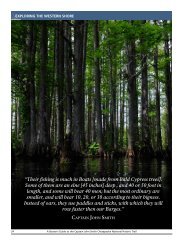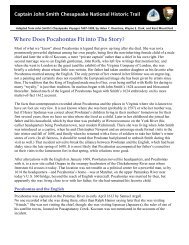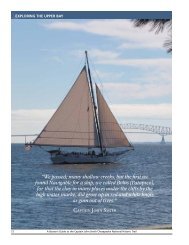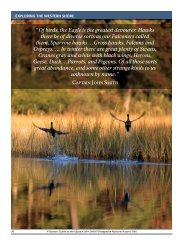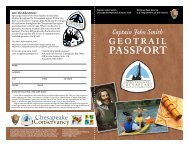Draft Interpretive Plan Join the adventure! - Captain John Smith ...
Draft Interpretive Plan Join the adventure! - Captain John Smith ...
Draft Interpretive Plan Join the adventure! - Captain John Smith ...
You also want an ePaper? Increase the reach of your titles
YUMPU automatically turns print PDFs into web optimized ePapers that Google loves.
proportion that he seemed <strong>the</strong> goodliest man that ever we<br />
beheld. His hair, <strong>the</strong> one side was long, <strong>the</strong> o<strong>the</strong>r shore<br />
close with a ridge over his crown like a coxcomb. His<br />
arrows were five quarters long [45 inches], headed with<br />
flints or splinters of stones in form like a heart, an inch<br />
broad and an inch and a half or more long. These he wore<br />
in a wolf’s skin at his back for his quiver, his bow in <strong>the</strong><br />
one hand and his club in <strong>the</strong> o<strong>the</strong>r as is described. . . .<br />
Five of <strong>the</strong> <strong>the</strong>ir chief werowances came boldly<br />
aboard us to cross <strong>the</strong> bay for Tockwhogh, leaving <strong>the</strong>ir<br />
men and canoes, <strong>the</strong> wind being so high <strong>the</strong>y durst not pass.<br />
Archaeological evidence from Susquehannock burial sites gives <strong>the</strong> lie to <strong>Smith</strong>’s<br />
description of <strong>the</strong>se Indians as “giants”—<strong>the</strong>y were of normal size. To impress <strong>Smith</strong>,<br />
<strong>the</strong> chiefs may have selected <strong>the</strong>ir tallest warriors for <strong>the</strong> delegation.<br />
Although much has been written about <strong>the</strong> later Susquehannock, much about <strong>the</strong>m at <strong>the</strong><br />
time of <strong>Smith</strong>’s encounter remains a mystery. Their name, Susquehannock, is what <strong>the</strong><br />
Tockwogh called <strong>the</strong>m; what <strong>the</strong>y called <strong>the</strong>mselves is not known. The principal town,<br />
which <strong>Smith</strong> called Sasquesahanough, has since been located through archaeological<br />
investigation at Washington Boro, Pennsylvania, on <strong>the</strong> eastern bank of <strong>the</strong> river.<br />
Apparently it had only been occupied since about 1600, when <strong>the</strong> Susquehannock moved<br />
<strong>the</strong>re from a location a short distance downstream at a place that archaeologists call <strong>the</strong><br />
Schultz site. The Susquehannock had only occupied <strong>the</strong> Schultz site for about twentyfive<br />
years when <strong>the</strong>y moved upstream to Washington Boro, having allegedly exhausted<br />
<strong>the</strong> woods and soil in <strong>the</strong> former place.<br />
The fact that <strong>the</strong> Susquehannock were Iroquoian speakers suggests a link to <strong>the</strong> Iroquois<br />
of present-day New York, where one branch of <strong>the</strong> river also has its headwaters. Pottery<br />
fragments found at sites in both New York and Pennsylvania support this <strong>the</strong>ory. The<br />
nature of that link, however, is unclear. Were <strong>the</strong> Susquehannock essentially Iroquois<br />
who migrated downstream (divergence), or were <strong>the</strong>y a separate group that shared certain<br />
cultural features with <strong>the</strong> Iroquois (convergence)? The question has not yet been<br />
answered. Similarly, assuming that <strong>the</strong> Susquehannock originated in New York, or at<br />
least far upstream, why did <strong>the</strong>y move to <strong>the</strong> lower part of <strong>the</strong> river? One <strong>the</strong>ory is that<br />
<strong>the</strong> Susquehannock was a trading route with European settlers at least as important as <strong>the</strong><br />
St. Lawrence River, and <strong>the</strong> Indians moved south to control a strategically vital location<br />
relative to trade via <strong>the</strong> Chesapeake Bay. That <strong>the</strong>ory, likewise, is <strong>the</strong> subject of debate.<br />
Excavations at <strong>the</strong> Susquehannock town site at Washington Boro have confirmed that it<br />
was palisaded and contained longhouses, not unlike some Powhatan towns. An estimated<br />
1,700 people lived <strong>the</strong>re. Soon, <strong>the</strong> Susquehannock became middlemen in <strong>the</strong> valuable<br />
beaver-pelt trade with <strong>the</strong> European settlers along <strong>the</strong> seaboard. Their location on <strong>the</strong><br />
river enabled <strong>the</strong>m to compete with o<strong>the</strong>r tribes, including <strong>the</strong> Iroquois, who periodically<br />
attacked <strong>the</strong>m. The Susquehannock, in turn, extended <strong>the</strong>ir influence into <strong>the</strong> Potomac<br />
River valley as far west as present-day Romney, West Virginia. The success of <strong>the</strong><br />
119



